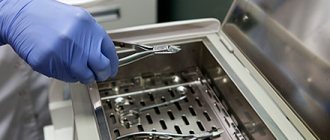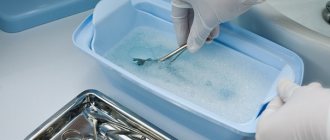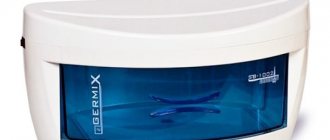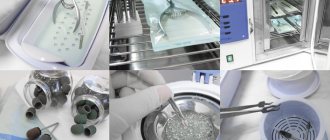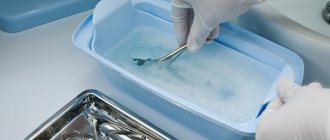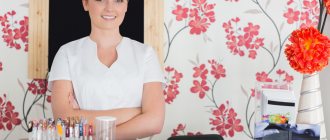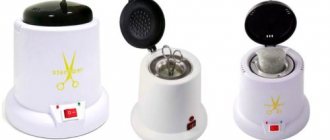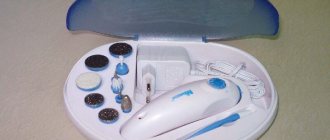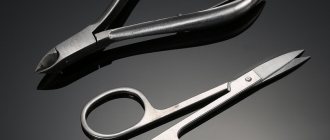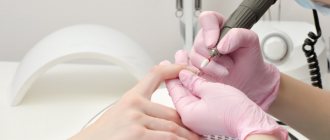What is a tendon
A dry-heat oven is an electric air sterilizer designed for processing instruments using hot steam.
The temperature in the dry heat is set from 160 to 220 degrees, which allows you to destroy harmful bacteria and dangerous microorganisms. Dry steam treatment is the final stage of instrument sterilization and cannot be used as the only method.
Dry heat is used for processing manicure instruments, in dental offices, tattoo parlors and medical institutions.
How and with what to disinfect, sterilize and clean manicure instruments
The processing time in a dry-heat oven depends on the temperature:
- At an indicator of 180-220 degrees – sterilization time is 30 minutes;
- From 170 to 180 – 60 minutes;
- 160-170 degrees – 150 minutes.
These indicators are averaged and may vary slightly depending on the specific model of the device. Before use, read the instructions and follow the manufacturer's recommendations.
Instruments in a dry-heat oven can be sterilized:
- Opened - on a tray or tray. In this case, the devices must be used immediately after treatment;
- Unopened - in special craft bags. Paper bags without impregnation allow you to store instruments after sterilization from 3 to 20 days, depending on the type. The packaging is opened immediately before the start of the procedure.
Advantages
- High-quality processing of the entire tool;
- Relative safety for metal tools;
- Ease of maintenance of the device. Sukhozhar does not require careful care. To maintain cleanliness, you only need to occasionally wipe it from the outside with an alcohol or disinfectant solution;
- Availability. Prices for dry roast start from 2,500 rubles. This allows you to purchase a cabinet even for home use;
Flaws
- Long full cycle. In the dry heat, instruments are sterilized for 30 to 150 minutes;
- Not suitable for all instruments - utensils made of glass, metal or porcelain are suitable for processing with dry hot air.
The best sterilizers for manicure instruments: TOP-13
| Photo | Name | Rating | Price | |||
| Ultraviolet sterilizer | ||||||
| #1 | Sunuv S2 | ⭐ 98 / 100 4 - votes | Find out the price | |||
| #2 | Germix TNL | ⭐ 97 / 100 1 - voice | Find out the price | |||
| #3 | JessNail Sterilizer JN-9007 | ⭐ 96 / 100 2 - votes | Find out the price | |||
| Ultrasonic sterilizer or washer-sterilizer | ||||||
| #1 | Washer-sterilizer VGT-2000 | ⭐ 99 / 100 2 - votes | Find out the price | |||
| #2 | ruNail, ultrasonic device for instruments | ⭐ 97 / 100 2 - votes | Find out the price | |||
| #3 | Sanitas SUR 42 | ⭐ 96 / 100 | Find out the price | |||
| Glasperlene and quartz sterilizers | ||||||
| #1 | IRISK 898 | ⭐ 99 / 100 5 — votes | Find out the price | |||
| #2 | Planet Nails MACROSTOP 139-10305 | ⭐ 99 / 100 3 - votes | Find out the price | |||
| #3 | Tools Sterilizer | ⭐ 98 / 100 | Find out the price | |||
| #4 | Glasperlene sterilizer TNL | ⭐ 97 / 100 2 - votes | Find out the price | |||
| Dry heat sterilizers | ||||||
| #1 | Sanitizing Box WX-12C | ⭐ 99 / 100 14 — votes | Find out the price | |||
| #2 | Lily KH-360B | ⭐ 98 / 100 7 — votes | Find out the price | |||
| #3 | Sanitizing Box CH-360T | ⭐ 97 / 100 16 — votes | Find out the price | |||
Which sterilizer did you choose or recommend?
Take the survey
This rating presents 13 popular models of sterilizers of various types, which have been preferred by manicurists for several years. Each of them is good in its own way. For convenience, the rating is divided into several categories depending on the type of devices described.
Please note that the editors of our site do not cooperate with commercial companies that sell equipment. And the rating is based on an analysis of reviews and user ratings that they post on popular review sites. This rating does not encourage you to buy the recommended models, it only gives an idea of which of them are currently popular and in demand, and you should not take it as a direct guide to buying any option.
Kraft package for dry heat
Kraft bag is a multi-layer paper product made from kraft pulp. The surface of paper packaging allows air molecules to penetrate inside, but prevents the penetration of microorganisms.
Types of craft bags:
- On paper clips . The period of preservation of sterility does not exceed 3 days;
- With self-adhesive tape . Allows you to store the treated instrument for up to 20 days.
How to use a craft bag correctly:
- Choose a bag of a suitable size - the longest tool should easily fit into it;
- Sign the package - indicate the date and time of sterilization, the client’s last name or other important data;
- Carefully place the devices in the bag;
- Seal the edges and place the bag in dry heat. Do not neglect to read the instructions for the sterilizer - find out the processing time and maximum capacity;
- At the end of the procedure, check the indicator on the bag - it should become contrasting with the original color. There is no single color palette, so read the manufacturer’s description in the craft package passport;
- Place the processed and packaged instrument in the UV cabinet until it is needed to be used, but not longer than the manufacturer recommends;
The use of tools from a craft package is prohibited if:
- The indicator did not change color;
- The Kraft bag has expired;
- Storage temperature conditions were not observed. After sterilizing the craft bag with tools, the room temperature should be maintained from +10 to +30 degrees, as well as air humidity not exceeding 50%.
Read more about craft bags >>
DEZlikbez. Issue 10. Indicators for sterilizers
In the next issue of the #DEZlikbez section we will talk about what indicators are, what they are intended for and how to use them correctly. Indicators are strips made of film and heat-resistant paper; they show whether sterilization was carried out correctly or not. Indicators control in the case of steam sterilization - temperature, period of its exposure, water vapor saturation; with the air method - temperature and duration of its exposure.
The indicator has markings and two colored marks, one of which is an indicator, and the other is a comparison standard.
Indicators are external and internal.
EXTERNAL indicators are placed inside the sterilizer on a tray like an envelope at five points (in the corners and in the center). There is no need to glue indicators to the tray!
If at least one indicator mark does not reach the final color (does not match the color of the standard), this is interpreted as a negative result.
If the external indicator shows a negative result, then the entire load of the sterilization cycle performed is considered non-sterile.
Please note that in this case the sterilizer requires technical inspection and possibly repair. An indicator that does not burn out may indicate problems with heating elements (heating elements), a violation of the tightness of the sterilizer chamber, and other malfunctions.
The indicators should be used during each sterilization cycle. Only five indicators are needed per cycle, regardless of how many bags are loaded into the chamber.
The installation of indicators is carried out by a person authorized for disinfection and sterilization, appointed by order and who has undergone proper training (working with an autoclave requires special training - a training cycle on working with pressure vessels).
After use, the external indicator is pasted into the sterilizer operation monitoring log. This document is used as evidence of a properly organized disinfection and sterilization regime and must be stored for three years from the date of completion of the records.
INNER indicators are glued to sterilization bags (Kraft bags) that do not have indicators, or are placed in each bag.
Now there are packages on sale both with and without indicators. If you purchased sterilization bags without an indicator, you are required to stick it to the bag before sterilizing your instruments.
The indicator serves as a guarantee that all sterilization conditions were met inside the package, and the instrument can be considered sterile.
If the internal indicator gives a negative result, then only the products inside this package are considered non-sterile. In this case, the sterilizer is also subject to mandatory technical inspection. Internal indicators are not recorded in any journal, and their use does not relieve the need to use external indicators. We hope you found this article helpful! If you have any questions, ask in the comments!
Watch our video about what indicators look like and how to use them correctly!
Types of tendons
Dry ovens differ in the range of functions, capacity and dimensions. You should choose a specific model based on the needs, customer mobility and the minimum set of functions required for you personally.
According to the type of loading, the device can be:
- Vertical. For example, CH-360T, suitable for small salons and home use.
- Horizontal. Recommended for use with large loads. As an option, consider the GP-20 model.
According to the principle of operation:
- Auto. It turns on independently after setting the temperature and time, and turns off after the procedure.
- Semi-automatic. The cycle is started manually.
According to the material of heating elements:
A heating element is a tubular electric heater, a device made of a tube, which heats the chamber in the sterilizer.
- Stainless steel. It is considered a classic material for the manufacture of heating elements. It has good thermal conductivity, but heats up slowly. It takes 10-15 minutes to completely warm up the chamber with stainless steel heating elements;
- Infrared heating elements heat up many times faster. Bring the operating temperature inside the chamber to maximum in 1-2 minutes. Infrared dryers are considered relatively new and have only recently begun to appear on sale, so their selection is still limited.
Comparison with other sterilizers
Along with dry heat, nail technicians use other devices designed for sterilization. Each of them has its own advantages and disadvantages. Choose a sterilizer only after fully studying all its functions and capabilities, so that after the purchase there are no unpleasant surprises or problems with the SES employees.
- Glasperlene Ball Sterilizer filled with glass beads. The instrument is disinfected quickly - only 20-30 seconds, but large instruments cannot be placed in such a device - the height of the working bowl does not exceed 15 centimeters. For example, a double-sided pusher 15-20 cm long will have to be sterilized in two approaches. Since the working surface is still processed, a glasperlene apparatus is used for the sterilization stage and does not violate SanPin requirements;
Properties of glasperlene sterilizer and rating of the best - UV sterilizer. An ultraviolet device is only a conditional sterilizer - most microorganisms survive exposure to ultraviolet radiation. UV cabinets are used as an intermediate storage place after treatment in a dry heater or autoclave before using instruments and cannot replace them at the sterilization stage;
- Ultrasonic sterilizer or, in other words, an ultrasonic cleaner - cleans using vibration of a special solution that envelops the devices. However, an ultrasonic bath is not a suitable device for the sterilization stage. Using the device, you can combine disinfection and pre-sterilization cleaning, reducing the number of processing steps from three to two. After ultrasonic cleaning, the devices are dried and placed in a dry heater or autoclave.
You cannot neglect the sterilization of instruments and for this you need to use specialized devices designed for this process - a dry heater, a ball or ultrasonic sterilizer, an autoclave.
Failure to comply with the rules of cleaning and sterilization in accordance with SanPiN 2.1.2.2631-10 entails a fine of 500 to 20,000 rubles or suspension of the work of the salon or office for up to 90 days. These actions, as well as the amount of sanctions, are regulated by the Code of Administrative Offenses of the Russian Federation, Article 6.3. “Violation of legislation in the field of ensuring sanitary and epidemiological welfare of the population.”
Autoclave and dry heat.
An autoclave is a sterilization device for processing instruments, affecting them using wet steam at a temperature of about 130 degrees, supplied under pressure.
Unlike a dry heater, an autoclave:
- Treats tools with wet steam, which leads to corrosion;
- Has a short full cycle - average sterilization time is 20 minutes;
- Works at lower temperatures - 125 - 130 degrees;
- Requires constant addition of distilled water;
- It costs two or more times more than dry heat. For example, a sterilizer-autoclave Prestige Medical Classic 2100 with a volume of 9 liters will cost about 65,000 rubles.
The autoclave is a full-fledged sterilizer and is used at the final stage of processing manicure instruments. Well, decide what to choose - an autoclave or a dry heater - based on your budget and your own desires.
Autoclave - features, choice and operating rules
Voting: which sterilizer is better?
Which sterilizer did you choose or recommend?
Sunuv S2
6.90 % ( 4 )
Germix TNL
1.72 % ( 1 )
JessNail Sterilizer JN-9007
3.45 % ( 2 )
Washer-sterilizer VGT-2000
3.45 % ( 2 )
ruNail, ultrasonic device for instruments
3.45 % ( 2 )
Sanitas SUR 42
0.00 % ( 0 )
IRISK 898
8.62 % ( 5 )
Planet Nails MACROSTOP 139-10305
5.17 % ( 3 )
Tools Sterilizer
0.00 % ( 0 )
Glasperlene sterilizer TNL
3.45 % ( 2 )
Sanitizing Box WX-12C
24.14 % ( 14 )
Lily KH-360B
12.07 % ( 7 )
How to choose
Choosing a dryer for home use or salons can seem like a daunting task, but a list of important criteria to pay attention to will help you figure it out.
- Cabinet volume. The capacity of the dryer is one of the important selection criteria. It is this criterion that is decisive in the search for a device for a beauty salon, where there is a high volume of clients. For home use, you can choose a device with a smaller capacity. The volume of the cabinet is measured in liters and ranges from 1.5 to 20. The volume of the oven inevitably affects the dimensions of the product - pay attention to this characteristic. There is no need to install a bulky cabinet with a capacity of 20 liters in a small manicure room, just as a small dryer would be out of place in a spacious salon. For home use or a small office, pay attention to the NV-210 model with a volume of 1.8 liters; for salons with high traffic volumes, the GP-10 MO with a 10-liter chamber is suitable;
- Additional functions. Some dryers are equipped with additional features. This list includes a timer with the ability to manually set the time after which the sterilizer will stop working. Some models are equipped with a function for cooling tools after heat treatment with hot steam. Modern sterilizers are complemented by the ability to synchronize with a computer to maintain an electronic processing log;
- Price. Even if you have a limited budget, the cost of the device should not be the determining factor. A very cheap dry heater may not meet the requirements of sterilization, for example, in terms of temperature;
- Heating rate. This indicator can vary from 2 to 5 degrees per minute. The higher the number, the more productive the dry heat;
- Availability of a cooling system. The dry-heat cabinet with cooling allows you to remove the treated tool immediately after the end of the cycle.
Rating of the 10 best models of dry-heat ovens.
Temperature in a dry heater - air sterilizer
The temperature regime of an air sterilizer is generally higher than that of an autoclave. Since there is no pressure and medium in the form of saturated water vapor, the volume needs to be heated much more strongly:
- Temperature of the dryer during operation:
50 - 200 °C - During sterilization, temperature in air cabinets:
160 - 200 °C - Processing / disinfection / sterilization time in general:
45 – 150 minutes
In custom modes or when working with dry heat in “manual” mode, these indicators can be changed, for example, exposure (processing time) can be increased to several hours, but in real work there is no such need).
Instructions for use
Dry steam treatment does not require special preparation, however, for high-quality sterilization it is better to follow the instructions for using a dry-heat oven:
- Turn on the dry heater;
- Place the tools inside the cabinet or place them in a craft bag. Use manicure tools that have been pre-dried in air or with a dry lint-free cloth if your dryer does not have a pre-drying function.
- Close the door;
- Set the processing temperature and sterilization time;
- Wait until the procedure is completed. Almost all sterilizers are equipped with a sound signal that notifies you when the cycle is complete.
- Leave the devices inside the sterilizer until they cool down, then remove them with gripping tweezers;
- Be careful - some dry roasts need to be preheated for 5-10 minutes. Before using the device, read the instructions.
Safety precautions
- Only those employees who have undergone safety training when working with a dry-heat oven are allowed to use the dry-heat oven;
- To ensure fire safety, the sterilizer is installed on a sheet of asbestos cardboard;
- Do not load the cabinet at temperatures above 40 degrees;
- After the end of the processing cycle, the dry-heat oven is disconnected from the network;
- To prevent overheating and damage to parts of the device, it should not be installed near heating systems, such as radiators.
SanPiN requirements for dry heat
When inspecting Rospotrebnadzor, special attention is paid specifically to the method of processing the tool and the devices intended for this.
If you are visited by SES officers, you must present:
- Registration certificate of a medical device. This document must come with the device. The certificate confirms the safety of the device;
- Instructions in Russian.
- Certificate or declaration of conformity;
- Contract of sale;
- Post warranty service agreement.
These requirements are dictated by Article 454 of the Civil Code of the Russian Federation and the requirements of SanPiN 2.1.2.2631-10 “Sanitary and epidemiological requirements for the location, structure, equipment, maintenance and operating hours of public utility organizations providing hairdressing and cosmetic services.”
Sanitary standards for beauty salons, manicures, hairdressers. Updated requirements 2021
Types of sterilization
Without going into details, all methods of processing tools can be divided into three types:
- Electrical. They assume the use of a special device with UV, infrared or other radiation.
- Chemical. For them, liquid agents are used that can disinfect the surface.
- Thermal. This type includes dry heat. It involves processing manicure tools at high temperatures. This method cleans the devices, allowing them to be reused for different clients.
